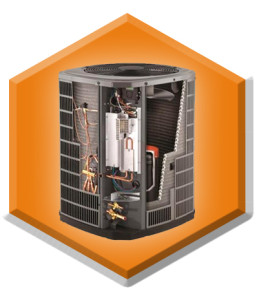Knowing the inner (and outer) workings of your home’s air conditioning system probably isn’t something you give too much thought to. Knowing how your air conditioner works not only helps when talking with a technician, but also helps you understand the importance of having your HVAC system inspected and maintained each year to keep it running efficiently.
The technology behind cooling our most important living spaces is ingenious and simple. It’s based on using a chemical refrigerant such as Freon®, which easily converts from gas to liquid, to transfer heat out of your home. An air conditioner cycles the refrigerant through its system, removing heat with each cycle, until your home has reached the desired temperature.
There are five major components that make up your home’s air conditioning system. They are:
- Air Handlers
- Compressors
- Evaporator Coils
- Thermostats, and
- Air Ducts
Air Handlers
An air handler is the indoor unit that provides conditioned air circulation through your home.
An air-handling unit includes a blower, heating and/or cooling elements, filter racks or chambers and dampers. Air handlers usually connect to ductwork that distributes the conditioned air throughout your home and returns it to the air handler.
If you have a forced air furnace, the air handler is the part that blows the hot air out. It probably also circulates cooled air from your air conditioner.
If you don’t have a furnace, you may have a stand-alone air handler to blow cool air from your air conditioner and/or hot air from your heat pump through your home’s ductwork.
Changing your filters regularly is the key maintenance for your air handler, whether it’s part of your furnace or a stand-alone unit. You should also have your entire system inspected and maintained by a professional each year to make sure that any potential problems are caught before they become bigger problems.
Call 256-536-0967 to set up an appointment with your Bunn’s and Bennett air conditioning specialist if you have questions about your air conditioning system.
Air Conditioner Compressors
What is an air conditioner compressor? This is a common question from home owners. The air conditioner compressor’s function is to squeeze (compress) the refrigerant, which arrives at the compressor as a cool, low-pressure gas. This added compression increases its energy and temperature, so the working fluid leaves the compressor as a hot, high-pressure gas.
This compressed, hot gas then passes to the condenser (the part of your air conditioner that has metal fins all around). The fins help to remove the heat more quickly. When the working fluid leaves the condenser, its temperature is much cooler and it has changed from a gas to a liquid under high pressure. It then heads inside to complete the cooling process in the evaporator coil.
In a central air conditioning system, the compressor (and the condenser) is located in the box outside your home. If your air conditioner runs, but is not cooling your home, the problem is often the air conditioner compressor.
It is important to keep your AC compressor clean. Clear away any leaves, grass clippings or debris from the housing and rinse it off with a hose. If you want to clean the aluminum fins inside, use a special fin tool or a paint brush and be careful not to bend them.
Evaporator Coils
The AC evaporator coil is the part of the air conditioning system that actually pulls heat out of your home’s air. After the compressor and condenser have turned the Freon into a cool liquid under intense pressure, the evaporator allows the liquid to evaporate, which extracts heat from the surrounding air, lowering the air temperature.
Now that you have cool air, it needs to circulate through your home—and that’s where the air handler comes in.
For your air conditioner to work efficiently, it’s important to keep your evaporator coil clean. Usually, this is as simple as changing your filter frequently—each month in the peak cooling months.
Thermostats
The thermostat is the remote control for your home’s heating and cooling systems. It works to control your system and deliver the exact room temperature you desire. There are two basic types: electro-mechanical thermostats and digital thermostats.
Electro-mechanical thermostats. Electro-mechanical thermostats are the older types with little metal coils and a mercury tube inside. As the temperature in a room shifts, the coils either contract or expand, pushing the mercury to one end of its tube or the other, which signals the HVAC system to either turn on or off.
Digital Thermostats. Digital thermostats are much more accurate at keeping your home comfortable. Most models today are programmable thermostats, which means you can set times for your system to run or shut down. Because you have much more control, you can possibly save on your energy costs by reducing your heat and cooling when you don’t need as much.
Call 256-536-0967 to set up an appointment with your Bunn’s and Bennett air conditioning specialist if you have questions about your air conditioning system.
Air Ducts
What most people don’t realize is that their equipment is only part of the solution. To fully feel the benefits of your air conditioning and heating system, your ductwork must be as well thought out—and maintained—as your HVAC unit.
Some new homes are being built with ductwork running through the conditioned living space. By constructing an insulated zone between the ceiling joists and a dropped ceiling, or between the walls mainly in the corners of a room, ducts can exist in an area where any lost air would contribute to the overall comfort of the home.
Of course you don’t have to build a new house to improve the efficiency of your ductwork. One thing you can look at is your duct’s configuration. A radial design, where air supplies and returns have direct connections to the unit, or a trunk and branch design, where supplies and returns branch off from a long “trunk” directly connected to the unit, are best for most houses.
Poorly planned or sloppily installed ducts can negate energy savings. Joints that aren’t sealed properly can allow a lot of that precious heated or cooled air to escape—as can old ductwork that may not be up to par with today’s new standards. Even newer ducts, when placed in areas where temperatures can be extreme (like attics), release a percentage of that comfy air.
Bunn’s and Bennett is a licensed and insured heating and air conditioning company, serving Huntsville and the Tennessee Valley for more than thirty years. Our awards for service and reliability are numerous, and our goal is to make your home comfortable. Feel free to contact us with any questions at [email protected].






